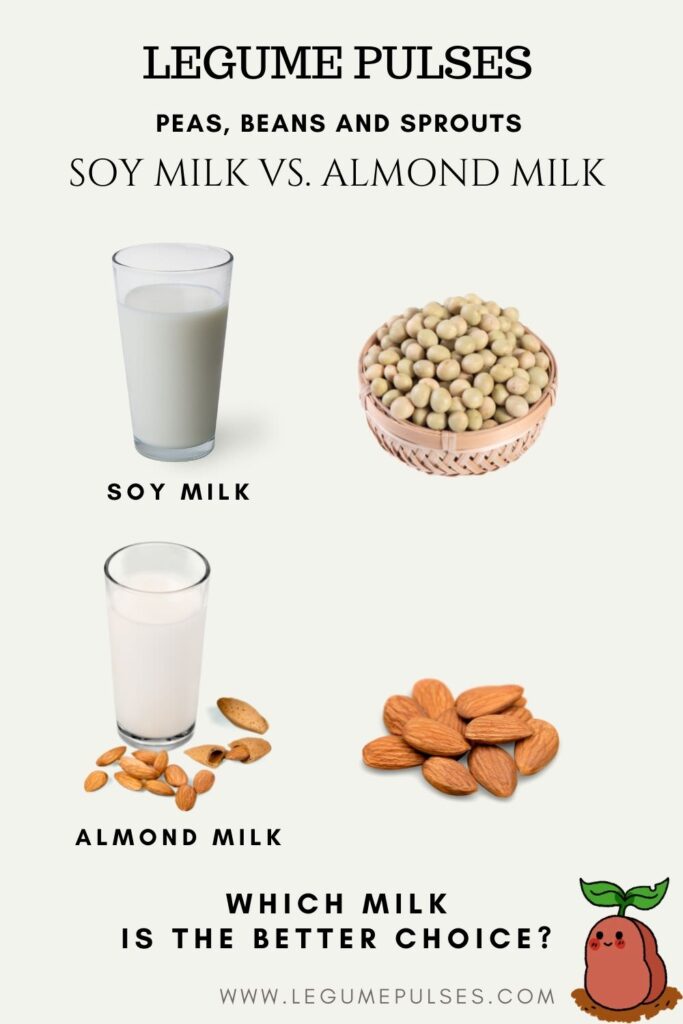Two popular alternatives to regular dairy milk are Soy and Almond. However, which is the best choice for your overall health. Although keeping both in your fridge is a good option so you can pick and choose. But it is good to know if one is healthier than another. Soy milk vs. almond milk, which is better for you?
Table Of Contents
- Reasons to choice soy and almond milk as a dairy alternative
- How is soy milk made?
- How is almond milk is made?
- Soy milk nutritional value
- Almond milk nutritional value
- Which is healthier, soy or almond milk?
- Advantages and disadvantages of soy milk
- Advantages and disadvantages of almond milk
- Taste test soy vs. almond milk
- Uses for almond and soy milk
- Conclusion Soy milk vs. almond milk

Why Choose A Dairy Alternative Such As Soy And Almond Milk?
You may want to choose an alternative for health reasons or personal beliefs. For many people, regular dairy milk is difficult to digest. And they have no option but to find an alternative, such as soy milk or almond milk.
Are Soy And Almond Milk Suitable For The Lactose Intolerant?
Many adults are lactose intolerant. This condition is more common than most people think. According to the U.S. National Library of Medicine, up to 65 percent of the human population is lactose intolerant after infancy. This condition is most common in people who are East Asian, West African, and Italian descent.1
Maintain A Healthy Weight By Reducing Calories From Animal Fat.
Another problem with regular milk is that it can contain calorie-dense, especially whole milk. This fact can be a problem for people trying to lose weight. People who have eczema also often cannot drink milk as it can cause flare-ups.
The Plant-Based Milk
The good news is that milk now comes from other sources, including
- Soy
- Almond
- Cashew
- Rice
- Coconut
- Kefir
- Hemp
- Oat
Taste And Nutrition Matter
Each of these kinds of milk varies in taste, nutrition, and consistency. But which non-dairy is the best choice?
To make the process a little easier for you, we will take an in-depth look at two popular types of plant-based kinds of milk — soy and almond.
Soy Milk Is Commonly Consumed In Asia.
The use of soy milk in the human diet can be traced back to the second century B.C. Soy milk was a staple in China and many parts of Asia because it is economical and nourishing.
In the middle of the fifteenth century, soy milk became popular in Europe. And it was not until the 1900s that it became widely available in the United States.
How Is Soy Milk Made?
Soy milk is created from soybeans that have been cooked, ground, and pressed, according to Silk, one of the largest producers of plant-based milk.2
Silk starts with whole-harvested soybeans. The whole bean is used to preserve taste and nutritional value. The beans are then split open and beans removed from the hulls. The beans are then ground and pressed.
During pressing, the insoluble fiber, called okara, is removed. Because the okara is very high in protein, it is saved and used by organic farmers as feed.
The leftover beans are then separated from raw soy milk. Various flavorings, minerals, and vitamins are added to the milk. Today soy milk is widely available. You can find it easily on the shelves of most stores.
Many People Around The World Drink Almond Milk.
Almond has been around since the early fifth century. It was consumed widely in:
- Eastern Asia
- Europe
- Spain.
How Is Almond Milk Made?
Almond milk is made with just two products — almonds and filtered water, according to Silk. The process starts with choosing almonds of the right size and density.
Then, the almonds are shelled, toasted, and ground. After that process, they are blended with filtered water. Vitamins, minerals, and flavorings are added.
Almond milk is quickly becoming one of the most popular milk alternatives. It is widely available. Like soy milk and other plant-based milk, almond milk is usually more expensive than milk.
Nutritional Comparison: Soy Milk Versus Almond Milk
So, how do the two kinds of milk stack up in terms of nutrition? Here is a breakdown of each.
Soy Milk (Organic Unsweetened – Silk brand) Based On 1 Cup Of Soy Milk
| Calories 80 | Cholesterol (MG) 0 | Carbs (grams) 4 | Sugars (grams) 1 | Protein (grams) 7 |
| Fat/Saturated Fat 4/.05 | Sodium (MG) .75 | Vitamin D (MCG) DV 15% | Calcium (MG/DV) 20% | Potassium (MG) 350 |
Soy milk is low in saturated fat and cholesterol-free. One cup of unsweetened, organic soy milk (Silk) has 80 calories, seven grams of protein, and more than 20 percent of the daily value of calcium, based on a 2,000 calorie diet. Soy milk is also high in vitamin D, potassium, and vitamin A. It is also a good source of B12 for vegans. Soy milk is lactose and dairy-free.
Almond Milk (Unsweetened from Silk) Based On 1 Cup Of Almond Milk
| Calories 30 | Cholesterol (MG) 0 | Carbs (grams) 1 | Sugars (grams) 0 | Protein (grams) 1 |
| Fat/Saturated Fat 2.5/0 | Sodium (MG) 125 | Vitamin D (MCG) DV 25% | Calcium (MG/DV) 45% | Potassium (MG) 35 |
Unsweetened almond milk has just 30 calories per cup. It is both lactose and dairy-free. While almond milk does not have as much protein as soy milk, it is low in carbs and contains no saturated fat.
Almond milk is high in vitamin D, vitamin E, Calcium, and potassium. Almond milk is one of the best non-dairy milk alternatives available if you want to add more calcium to your diet. One cup has a whopping 45 percent daily value of calcium.
Which Is Healthier?
So, in terms of nutrition, which milk is healthier? Both soy milk and almond milk are much lower in calories than regular whole milk. Which has 150 calories per 8-ounce serving. They both have a lot less sugar. Standard dairy milk has 12 grams of sugar, while soy milk has 1 gram and almond milk has none. Soy milk has almost as much protein as regular milk. So experts often say it is the healthiest.
Why Soy Milk Is Better
Researchers at McGill University in Canada recently compared the nutritional profiles of four popular types of plant-based milk — soy, almond, coconut, and rice. They found that soy milk was the most comparable to dairy milk in overall nutritional balance. According to the researchers, almond milk lacks essential nutrients vital for overall health, including protein.3
Soy milk may also help reduce the risk of heart disease. According to experts, 25 grams of soy protein a day can help reduce the risk of heart disease. Numerous research studies have backed up this claim. Soy protein, when included in a low-fat, low-cholesterol diet. Can reduce so-called bad (LDL) cholesterol levels. Without lowering good cholesterol in the blood.4
Why Almond Milk Is Better
However, soy milk may not be the healthiest choice for everyone. There are some advantages to almond milk that may make it a better choice for certain people. Almond milk is low in calories, making it great for anyone on a low-calorie diet.
It is also high in monounsaturated fats, which can help weight loss. So, almond milk may be a better alternative for anyone who wants to lose weight.
Almond milk is also a better choice for people on low-carb diets, such as those who have diabetes or are on the Keto diet. Almond milk contains just one gram of carbs vs. four in soy milk.
To figure out which plant-based milk is healthiest for you. It helps to compare the advantages and disadvantages of both.
Advantages Of Soy Milk
The benefits of soy milk over almond milk are that it is:
- High in protein
- High potassium
- Low in sodium
- Excellent source of vitamin B12
- It may help lower the risk of heart disease
- Contains phytonutrients (isoflavones), which may help fight cancer.5 ]
To learn about the potential health benefits of drinking soy milk, click the link.
Disadvantages Of Soy Milk
Soy milk does have some disadvantages. One of the drawbacks to soymilk is that it contains the isoflavones daidzein and genistein, which act like estrogen within the body. And is said to play a role in cancer and other health problems.
However, the American Cancer Society says that there is no link between soy and cancer in humans. Although some studies found a link between cancer and soy, they were animal studies, not human.6
Advantages Of Almond Milk
Compared to soy milk, almond milk is:
- Lower in calories
- Fewer carbs
- Less fat
- Lower in saturated fat
- Higher in calcium
Disadvantages Of Almond Milk
Almond milk contains phytic acid. Phytic acid can make it harder for the body to absorb and digest essential minerals and vitamins. However, phytic acid is an important antioxidant that has health benefits, as well.7
Taste Test: Soy Milk vs. Almond Milk
The taste of plant-based milk can vary significantly from brand to brand. So, which milk tastes better? It depends on your taste preferences and the brand you select. Here is a general comparison of the taste differences between soy and almond milk.
Soy Milk
Unsweetened soy milk tastes the most similar to regular milk. Naturally, it does have a slight bean flavor, which some people may not like. The flavor is often an acquired taste.
Soy milk has a creamy texture. The texture makes it a great coffee creamer. So this is one of the reasons why soy lattes are so popular. Soy milk is also available in vanilla and chocolate flavors, so you can still get that milkshake flavor.
Almond Milk
Almond milk has a slightly nutty flavor since it is made from almonds. It has a sweeter taste than soy milk, but it is not too sweet. Almond milk also has a slightly creamy texture. Like soy milk, almond milk also comes in chocolate and vanilla flavors. Other flavors may include:
- pumpkin
- banana
- honey
Almond milk is sometimes blended with other plant-based milk, such as cashew or coconut.
So, which milk wins in terms of taste? That depends on your individual preferences. If you prefer a slightly sweet taste, you would probably like almond milk better than soy. However, if you drink a lot of coffee, soy milk tastes delicious when blended with coffee.
Which Is Better For Cooking, Soy Milk Or Almond Milk?
According to Silk, both soy milk and almond milk can be used in almost any recipe — so it is a tie. Both are delicious in everything from smoothies to baked goods.
Tips For Cooking With Soy and Almond Milk
- Avoid too much heat – Just like standard milk, plant-based alternatives can scorch if cooked too high. They will also form skin. So, stick to medium heat.
- Do not freeze – Silk does not recommend freezing any of its plant-based milk varieties because it causes problems with the taste and consistency.
- Add cornstarch to thicken – To thicken a sauce using soy or almond milk, add a little cornstarch to the recipe.
- Use it to sweeten treats – Use vanilla or chocolate soy or almond milk to add a little extra flavor to oatmeal, parfaits, and puddings.
- Make simple swaps to increase nutrition – To improve the nutritional value of your favorite recipes, swap soy or almond milk. You can swap it for milk in shakes and smoothies, mashed potatoes, soups, and more.
Soy Milk vs. Almond Milk
In conclusion, soy milk and almond milk are excellent alternatives to cow’s milk. Both can be part of a balanced, healthy diet. And both of these milk is vegan and lactose-free. Almond milk is low-calorie and fat-free. This makes it an excellent choice for anyone on a low-carb or heart-healthy diet. Almond milk is sweeter than soy milk, making it great for desserts. Soy milk is an excellent source of protein. It has a creamy texture, and it should be your first choice when you make a cup of coffee.
And if you want to learn about soy milk vs. dairy milk, click on the link for another well-researched article.
References:
- https://ghr.nlm.nih.gov/condition/lactose-intolerance#statistics
- https://silk.com/products/learn-more/about-soymilk.
- https://link.springer.com/article/10.1007%2Fs13197-017-2915-y
- http://www.soyfoods.org/nutrition-health/soy-for-healthy-living/soy-for-heart-disease/soy-protein-and-heart-disease-health-claim
- http://www.aicr.org/reduce-your-cancer-risk/diet/elements_phytochemicals.html
- https://www.cancer.org/latest-news.html







